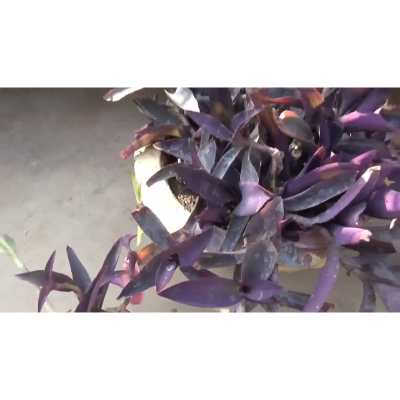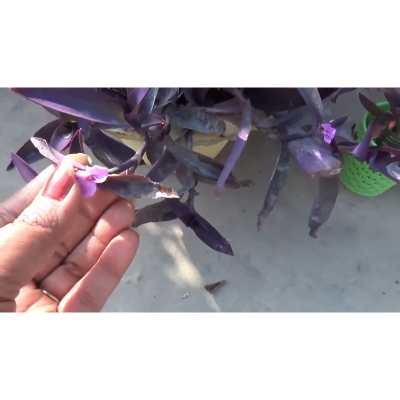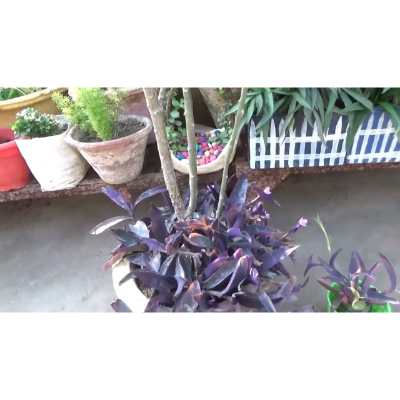Yes, Purple Heart plant is an adaptable species that does well both inside and outside, which is why plant lovers like it so much.
Introduction
The Purple Heart plant, scientifically referred to as Tradescantia pallida, is a captivating botanical marvel that has been enchanting gardeners and indoor plant enthusiasts for generations.
With its colourful pink foliage and easygoing nature, this perennial beauty is both a satisfaction to the eyes and a breeze to domesticate. Whether you are wondering if it is appropriate for indoor or outside increase or looking for suggestions on its care, you have come to the right place.
In this complete article, we’re going to discover the many sides of the Purple Heart plant, from its best growing situations to its propagation and protection. Let’s embark on a journey to unravel the mysteries of this excellent plant.
Is Purple Heart Plant Indoor or Outdoor?

Yes, Purple Heart plant is a flexible species which can thrive each indoor and outdoors, making it a famous desire among plant fans. Let’s delve into the specifics of every placing:
Indoor Cultivation
The Purple Heart plant is regularly grown indoors, wherein its precise aesthetic traits can be showcased 12 months-spherical. Here are some key points to bear in mind while cultivating this plant indoors:
Table of Contents
- Hanging Baskets: Many gardeners prefer to grow the Purple Heart plant in placing baskets. This lets in the cascading stems and striking purple leaves to drape gracefully, creating a visually attractive show.
- Interiorscapes: In interior landscaping, Purple Heart flora are frequently used as groundcovers. Their low-developing addiction and appealing foliage lead them to an extraordinary preference for adding a hint of nature to indoor spaces.
- Sunlight Requirements: When developing the Purple Heart plant indoors, it’s critical to provide it with sufficient light. Place it in an east-going through window to get hold of mild morning daylight. Avoid exposing it to intense afternoon solar, as this could lead to leaf discoloration. While this plant craves sunlight, moderation is key.
- Humidity: Purple Heart flowers thrive in humid situations, akin to their local tropical habitat. To mimic those conditions interior, remember the usage of a humidifier or misting the plant frequently.

Outdoor Cultivation
If you opt to cultivate the Purple Heart plant in an outdoor lawn, you’re in good fortune. This resilient perennial can flourish while planted inside the proper environment:
- Hardiness Zones: The Purple Heart plant is well-perfect for outside boom in USDA hardiness zones 7–eleven. In those areas, it can withstand slight winters and keep growing during the 12 months.
- Sunlight Requirements: When grown outdoors, this plant appreciates enough sunlight. Provide it with as a minimum 6 hours of daylight in keeping with day, but make sure it’s far protected against sizzling afternoon sun, particularly in warmer climates. Partial color can be useful.
- Climate Considerations: Purple Heart flowers thrive in humid climates, so if you’re developing them outdoors in drier areas, it is crucial to screen soil moisture tiers and provide normal watering.
In summary, the Purple Heart plant is a versatile botanical treasure which could thrive both indoors and exterior. By information its precise requirements in every placing, you can create a colourful and visually appealing lawn or indoor display.

Varieties of Purple Heart Plant
The Purple Heart plant is available in various captivating varieties, each with its own unique functions. Let’s discover some of the famous striped sorts and their awesome traits:
- Tradescantia pallida ‘Purple Heart’: This is the classic Purple Heart plant with colourful purple foliage. Its trailing stems and wealthy coloration make it a favorite choice for putting baskets and groundcovers.
- Tradescantia pallida ‘Variegata’: This variety showcases variegated leaves with stripes of crimson and inexperienced. The hanging contrast provides an additional layer of visual appeal on your garden or indoor area.
- Tradescantia pallida ‘Pink Stripe’: As the call shows, ‘Pink Stripe’ functions brilliant crimson stripes on its leaves, growing a visually beautiful and desirable display.
- Tradescantia pallida ‘Nanouk’: ‘Nanouk’ is known for its pastel-colored leaves, ranging from red to mild pink. This range brings a tender and sensitive contact for your plant series.
Propagating Purple Heart Plants

One of the exciting components of worrying for Purple Heart vegetation is their ease of propagation. Whether you need to percentage this captivating plant with buddies or increase your collection, propagating it could be a worthwhile enjoy. Here are some strategies you may use:
- Cuttings: Taking stem cuttings from a mature Purple Heart plant is a commonplace and powerful manner to propagate it. Here’s how to do it:
- Select a healthy stem with several leaves.
- Use easy, sharp scissors or pruning shears to make a smooth reduce just below a leaf node (the factor where a leaf attaches to the stem).
- Remove the lower leaves, leaving a few at the pinnacle.
- Allow the reducing to air dry for some hours to shape a callus.
- Plant the cutting in a nicely-draining potting blend and water it gently.
- Place the pot in a vibrant, oblique mild region.
- Keep the soil continually wet however not soggy.
- Roots must increase inside some weeks, and you may soon have a new Purple Heart plant.
- Division: If you have a mature Purple Heart plant that has grown quite large, you could divide it into smaller vegetation. This can rejuvenate the authentic plant and offer you with new specimens.
- Carefully get rid of the plant from its pot or lawn mattress.
- Gently separate the root mass into sections, making sure that every section has each roots and stems.
- Replant the divided sections in fresh soil and water them very well.
- Keep the newly divided vegetation in a suitable environment with the proper lighting and moisture situations.
- Leaf Cuttings: Although less common, Purple Heart flowers can also be propagated from character leaves. Here’s the way to do it:
- Select a wholesome leaf from the figure plant.
- Cut the leaf into sections, every containing a portion of the central vein.
- Plant these leaf sections in a properly-draining potting blend, burying them in part.
- Maintain the proper moisture stages and lighting fixtures conditions.
- Over time, new vegetation will emerge from the base of the leaf sections.
Propagation can be a charming manner to increase your Purple Heart plant collection or percentage the joy of this beautiful plant with others.
Maintenance and Care Tips

Caring for your Purple Heart plant, whether indoors or outdoors, is enormously trustworthy. Here are a few crucial protection guidelines to make certain its fitness and vibrancy:
- Watering: Purple Heart flowers choose continuously moist soil however not waterlogged conditions. Allow the top inch (2.Five cm) of soil to dry among waterings. Adjust the frequency based totally for your precise developing environment.
- Fertilization: During the growing season (spring and summer season), feed your Purple Heart plant with a balanced liquid fertilizer diluted to 1/2 electricity each 4-6 weeks. Reduce or eliminate fertilization throughout the dormant winter months.
- Pruning: Regularly trim returned leggy or overgrown stems to inspire bushier increase. Pruning is likewise an terrific manner to govern the size and shape of your plant.
- Pest and Disease Management: Purple Heart vegetation are usually resilient, however they can be prone to pests like spider mites and aphids. Inspect your plant frequently for signs and symptoms of infestation and take appropriate measures, which include the use of neem oil or insecticidal cleaning soap, if wished.
- Repotting: If your Purple Heart plant outgrows its pot or will become root-sure, take into account repotting it right into a slightly large box with fresh potting mix. Repotting is typically important every 2-3 years.
- Winter Care: In areas with cold winters, bring your outdoor Purple Heart plants interior before the primary frost. Place them in a vibrant location with decreased watering to permit for dormancy.
Mysterious Allure of the Purple Heart Plant
Beyond its stunning appearance and ease of care, the Purple Heart plant holds a mysterious enchantment that has captured the imaginations of many. Legends and folklore have woven tales of its magical houses, making it a image of appeal and marvel. Here, we discover the thrilling stories and beliefs associated with this charming plant.
Mythological Connections
In numerous cultures, the Purple Heart plant has been related to myths and legends. In ancient Greek mythology, it changed into believed to be associated with Eros, the god of love, due to its coronary heart-original leaves. According to the tale, folks who possessed the plant may additionally need to harness its electricity to encourage love and desire.
Healing and Protective Properties
Throughout statistics, the Purple Heart plant has been reputable for its intended recovery and shielding houses. Some believed that sporting a spray of Purple Heart leaves may additionally want to push back negative energies and offer safety in the direction of evil spirits. In traditional medicinal drug, it modified into used to deal with numerous illnesses, from digestive problems to pores and pores and skin situations.
Symbolism in Art and Literature
The captivating appearance of the Purple Heart plant has additionally made it a famous trouble in artwork and literature. It has been featured in art work, poems, and stories, regularly representing issues of love, mystery, and transformation. Its vibrant red color and unique growth pattern have stimulated countless artists and writers.
Modern-Day Appeal
Today, the Purple Heart plant continues to captivate humans worldwide. Its captivating beauty and simplicity of care make it a liked addition to homes, gardens, and botanical collections. Whether it is cherished for its aesthetic traits or the experience of marvel it evokes, the Purple Heart plant stays a deliver of fascination.
Purple Heart Plant Fun Quiz
Now that we’ve explored the captivating world of Purple Heart plants, let’s put your knowledge to the test with a fun quiz. Answer the following questions to see how much you’ve learned!
Question 1: What is the scientific name of the Purple Heart plant?
a) Tradescantia purpurea b) Tradescantia pallida c) Purpleus hearticus d) Violeta splendidus
Question 2: In which USDA hardiness zones can the Purple Heart plant be grown outdoors?
a) Zones 1–6 b) Zones 4–9 c) Zones 7–11 d) Zones 9–12
Question 3: Which method of propagation involves taking stem cuttings from a mature Purple Heart plant?
a) Division b) Leaf cuttings c) Root division d) Cuttings
Question 4: What is the significance of the Purple Heart plant in ancient Greek mythology?
a) It was associated with the god of war. b) It symbolized wisdom and knowledge. c) It was linked to the god of love, Eros. d) It represented the underworld.
Question 5: What is the recommended sunlight exposure for indoor Purple Heart plants?
a) Full sunlight all day b) Direct afternoon sun c) Bright, indirect light d) Complete darkness
Question 6: What color variations are found in the ‘Nanouk’ variety of the Purple Heart plant?
a) Pink to light purple b) Deep purple c) Green and yellow d) Orange and red
Question 7: What is a common method for controlling pests on Purple Heart plants?
a) Pruning the affected leaves b) Spraying with vinegar c) Using neem oil or insecticidal soap d) Playing soothing music
Question 8: What is the ideal time to fertilize Purple Heart plants during the growing season?
a) Every day b) Every 2-3 weeks c) Every 4-6 weeks d) Never
Question 9: What is the Purple Heart plant associated with in art and literature?
a) Themes of love, mystery, and transformation b) Themes of war and conflict c) Themes of science and technology d) Themes of agriculture and farming
Question 10: In which season should outdoor Purple Heart plants be brought indoors in regions with cold winters?
a) Spring b) Summer c) Fall d) Winter
Conclusion
The Purple Heart plant, with its captivating pink foliage and flexible nature, continues to captivate plant fanatics worldwide. Whether you pick out to develop it indoors in striking baskets or use it as a groundcover for your outside garden, this superb plant is sure to deliver pleasure and splendor to your area. With the expertise received from this article, you may expectantly take care of your Purple Heart plants, propagate them, and appreciate their mysterious attraction. As you tend for your Purple Heart plant life, you grow to be part of a tradition that spans cultures and centuries, celebrating the magic of this botanical marvel.
So, whether or not you are a pro gardener or a budding plant enthusiast, embody the Purple Heart plant and let its colourful colours and intriguing history brighten your international. Happy gardening!
